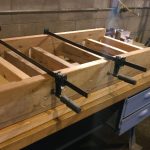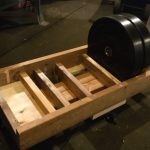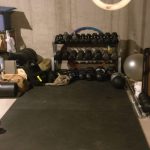Today is the tenth anniversary of the open heart surgery that saved my life.
I cannot say thank you enough to my wife, Angela, my family and friends for rallying around me, praying for me, driving hours across southern Minnesota to give me a 15-minute ride home from Cardiac Rehab, for phone calls, letters and cards showing your support. Thank you Jason L. for driving me to Cardiac Rehab 3x per week for eight weeks, to Craig L. for “stopping by” with enough BBQ to feed us for a week straight, to Aunt Judy and Uncle Bern for the “Keep Calm and Eat Cookies” t-shirt, so Jim and Robbi for the duck-brand duct tape with penguins on it (which I still look at and chuckle every time).
Thank you also to the wonderful care providers at North Memorial Heart and Vascular Center for enduring my endless questions and for taking such good care of me, and of Angela as well, as we tried to understand my disease and to eventually accept the surgery required to save my life.
If you want to get an idea of world-class bedside manner leading up to cardiac surgery, watch this short video of my cardiac surgeon, Dr. King at North Memorial Heart and Vascular. Words fail in describing the gratitude I feel for how he cared for Angela, as she struggled to process the idea of me undergoing open heart surgery, while I compartmentalized and jumped straight to acceptance of a terrifying, but life-saving operation.
My condition was chronic (not acute), but my profound atrial septal defect certainly would have killed me. It might have been slowly via congestive heart failure, or quickly if one of my Transient Ischemic Attacks (small, temporary strokes) wasn’t so small and hit a more critical part of my brain.
Every year since I take today off to visit my cardiac rehab nurses and thank them for helping make the world feel safe again. Shout out to St. Francis Cardiac Rehab; your work is vital.
(I have also tried visiting my cardiology and cardiac surgery care teams, but I’m not a great planner, and they’re not as readily accessible.)
Unlike last year and years past, I didn’t break down sobbing while thanking my cardiac rehab nurses; and I think I know why.
For starters, two years ago I began writing about my diagnosis, surgery, and recovery. Through writing and sharing some of that writing, I finally started to process all the fear, worry, and anxiety which I had kept compartmentalized for ten years.
Part of my story, which I haven’t shared widely, includes struggling in the months following surgery.
Physically, everything went swimmingly. I was back in the gym and did ½ of Murph (1/2 mile run, 50 pullups, 100 pushups, 150 squats, then another 1/2 mile run) eight weeks after surgery. My patched heart thumped away vastly more efficiently with a “cow patch” in place of my native fenestrated, aneurysmal atrial septum.
Unexpectedly, the cognitive, mental, and emotional struggles lingered for months after my physical recovery was complete. It turns out that a couple of TIAs and an open heart/cardiopulmonary bypass procedure were hard on my brain.
As I shared my story with others, people started sharing their stories with me.
Through telling my own story and listening to the stories of others, an unexpected pattern emerged; virtually everyone whose loved one had open heart surgery or had open heart surgery themselves, shared stories of cognitive struggles after surgery.
Some of these stories were merely annoying, like the text I received that said, “I’m in Walgreens, and I have no idea why I’m here.”
Others were more serious, like the friend who shared with me that, after his operation, there was new friction in his marriage as he and his wife adjusted to his new post-op forgetfulness.
Others were tragic, like the friend who shared that her uncle took his own life mere months after a heart attack and open-heart triple bypass surgery, despite no history of mental illness.
The other thing these stories had in common was the lack of awareness that there was a risk of cognitive, mental, and emotional symptoms after an open heart operation, and the lack of understanding that resources were available should those symptoms arise.
That lack of awareness led to months of quiet post-op struggle for each person, struggle for their loved ones, and in my friend’s opinion of one tragic case, suicide.
As I sat in my car in the parking lot outside St. Francis Cardiac Rehab, wondering why I wasn’t sobbing my eyes out, the reason occurred to me; I finally knew what to do;
I want to change the standard of care for open heart surgery to include pre-op and post-op cognitive, mental, emotional, and behavioral care.
I don’t know how I will do it, but I know that my own story, and the stories of other heart surgery patients and their loved ones will be a part of it.
If you know someone who has had heart surgery, ask them if they’d like to tell you their story, and simply listen to them. If you’ve had cardiac surgery, consider sharing your story with a loved one. It might be cathartic to both of you.
I’m also in the process of writing a book about my own story. If you’d like to help me with that, please subscribe to my email list, or message/follow me on Twitter or LinkedIn, and I’ll keep you posted as I turn my manuscript into a book and explore other ways to get better care for heart surgery patients.


